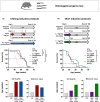A single short reprogramming early in life initiates and propagates an epigenetically related mechanism improving fitness and promoting an increased healthy lifespan
- PMID: 36251933
- PMCID: PMC9649606
- DOI: 10.1111/acel.13714
A single short reprogramming early in life initiates and propagates an epigenetically related mechanism improving fitness and promoting an increased healthy lifespan
Abstract
Recent advances in cell reprogramming showed that OSKM induction is able to improve cell physiology in vitro and in vivo. Here, we show that a single short reprogramming induction is sufficient to prevent musculoskeletal functions deterioration of mice, when applied in early life. In addition, in old age, treated mice have improved tissue structures in kidney, spleen, skin, and lung, with an increased lifespan of 15% associated with organ-specific differential age-related DNA methylation signatures rejuvenated by the treatment. Altogether, our results indicate that a single short reprogramming early in life might initiate and propagate an epigenetically related mechanism to promote a healthy lifespan.
Keywords: aging; epigenetics; longevity; metabolism; transient reprogramming.
© 2022 The Authors. Aging Cell published by Anatomical Society and John Wiley & Sons Ltd.
Conflict of interest statement
The authors declare that they have no competing interests.
Figures





References
-
- Abad, M. , Mosteiro, L. , Pantoja, C. , Cañamero, M. , Rayon, T. , Ors, I. , Graña, O. , Megías, D. , Domínguez, O. , Martínez, D. , Manzanares, M. , Ortega, S. , & Serrano, M. (2013). Reprogramming in vivo produces teratomas and iPS cells with totipotency features. Nature, 502(7471), 340–345. 10.1038/nature12586 - DOI - PubMed
-
- Banito, A. , Rashid, S. T. , Acosta, J. C. , Li, S. , Pereira, C. F. , Geti, I. , Pinho, S. , Silva, J. C. , Azuara, V. , Walsh, M. , Vallier, L. , & Gil, J. (2009). Senescence impairs successful reprogramming to pluripotent stem cells. Genes & Development, 23(18), 2134–2139. 10.1101/gad.1811609 - DOI - PMC - PubMed
-
- Browder, K. C. , Reddy, P. , Yamamoto, M. , Haghani, A. , Guillen, I. G. , Sahu, S. , Wang, C. , Luque, Y. , Prieto, J. , Shi, L. , Shojima, K. , Hishida, T. , Lai, Z. , Li, Q. , Choudhury, F. K. , Wong, W. R. , Liang, Y. , Sangaraju, D. , Sandoval, W. , … Izpisua Belmonte, J. C. (2022). In vivo partial reprogramming alters age‐associated molecular changes during physiological aging in mice. Nature Aging, 2, 243–253. 10.1038/s43587-022-00183-2 - DOI - PubMed
Publication types
MeSH terms
LinkOut - more resources
Full Text Sources

